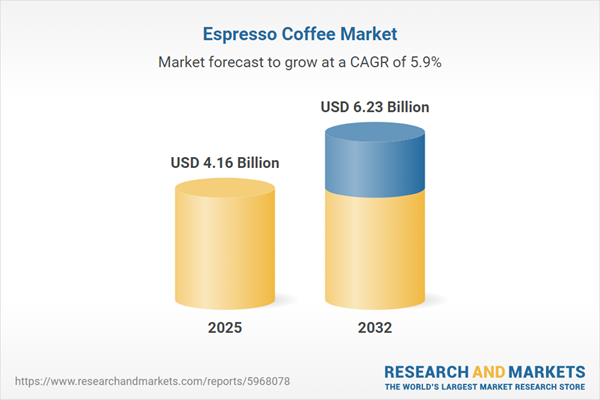Speak directly to the analyst to clarify any post sales queries you may have.
Senior decision-makers in the espresso coffee market operate in a rapidly evolving landscape with changing consumer preferences, stringent regulations, and shifting supply chain dynamics. Reliable, actionable insights are critical for building adaptive strategies and sustaining competitive edge in this sector.
Market Snapshot: Global Espresso Coffee Market Overview
The global espresso coffee market continues to demonstrate steady expansion, valued at USD 3.93 billion in 2024, with projections of reaching USD 4.16 billion by 2025 and USD 6.23 billion in 2032, representing a CAGR of 5.91%. Factors fueling this momentum include the growing demand for premium espresso coffees and advancements in espresso brewing technology. Companies are leveraging innovations in espresso machinery and supply chain models to address evolving expectations in both commercial and residential settings. As brands increasingly prioritize product differentiation, they are also adapting to new consumption trends across diverse markets.
Scope & Segmentation: Espresso Coffee Market Structure
- Machine Types: Automatic pump, capsule-based, steam-driven, manual, and semi-automatic machines are tailored to the functional needs of corporate, hospitality, and residential outlets by supporting distinct brewing processes and capacity requirements.
- Distribution Channels: E-commerce, specialty retailers, supermarket chains, and online storefronts are enabling businesses to optimize reach and target different customer profiles more effectively.
- End Users: Commercial venues, office settings, and private households each require unique approaches—be it for efficiency, service quality, or enhanced user experience—to secure market loyalty in various environments.
- Bean Types: Arabica, Robusta, and specialty blends serve to meet consumer demand for flavor variety, ethical sourcing, and flexible procurement, supporting distinct positioning from mainstream to niche segments.
- Roast Levels: Dark, medium, and light roasts allow producers and retailers to align offerings with global and demographic taste preferences, supporting ongoing product innovation.
- Price Ranges: Premium, mid-tier, and entry-level products are crucial for enabling value-based segmentation and aligning offerings with buyer priorities, whether oriented toward unique features or affordability.
- Regional Focus: North America, Latin America, Europe, the Middle East, Africa, and Asia-Pacific each present individual regulatory considerations, market habits, and consumer cultures, making tailored strategies and localized supply chains a necessity.
Key Takeaways: Strategic Insights for the Espresso Coffee Market
- Market premiumization has intensified, with single-origin and plant-based espresso options responding to increasing consumer interest in ethical sourcing and wellness considerations.
- Automation and capsule systems are streamlining processes for institutions and households, boosting operational efficiency and ensuring consistency in espresso quality.
- Corporate sustainability strategies are moving to the forefront, with transparent supply practices and eco-friendly packaging supporting compliance and fostering consumer trust.
- Strategic growth in Asia-Pacific and Latin America is accelerating as alliances with local distributors improve market responsiveness and address unique regional consumer preferences.
- Integrated value chains are becoming standard, as equipment providers, coffee suppliers, and technology partners collaborate to enhance customer service at all stages.
Tariff Impact: Managing United States Policy Shifts
Recent changes to United States tariffs on espresso machinery and coffee beans are prompting businesses to diversify sourcing and build more resilient supplier partnerships. These adjustments are supporting supply chain agility and reducing exposure to future regulatory shifts by prompting backup supplier network development and greater domestic production capacity.
Methodology & Data Sources
This market analysis incorporates a multi-faceted methodology, including data triangulation, SWOT analysis, scenario planning, and Porter’s Five Forces model. Insights are gathered from executive interviews, sector surveys, scholarly research, and academic sources to provide a robust, verifiable intelligence base.
Why This Report Matters to Business Leaders
- Delivers a comprehensive benchmarking platform for product and technology evaluation in the espresso coffee sector, supporting long-term planning and comparison against competitors.
- Enables senior leaders to adapt proactively to regulatory and supply chain challenges using frameworks built for resilience in market volatility.
- Supplies actionable insights on evolving consumer behavior, alliances, and technology, underlining priorities for sustained innovation and risk management.
Conclusion
Securing success in the espresso coffee market relies on leveraging innovation, supply chain flexibility, and precise regional strategies. Informed, data-driven decisions enable leaders to respond confidently to change and identify emerging growth opportunities.
Additional Product Information:
- Purchase of this report includes 1 year online access with quarterly updates.
- This report can be updated on request. Please contact our Customer Experience team using the Ask a Question widget on our website.
Table of Contents
3. Executive Summary
4. Market Overview
7. Cumulative Impact of Artificial Intelligence 2025
Companies Mentioned
The companies profiled in this Espresso Coffee market report include:- Nestlé S.A.
- JDE Peet's N.V.
- Starbucks Corporation
- Luigi Lavazza S.p.A.
- Keurig Dr Pepper Inc.
- Tchibo GmbH
- illycaffè S.p.A.
- Dunkin' Brands Group, Inc.
- Melitta Europa GmbH & Co. KG
- Strauss Group Ltd.
Table Information
| Report Attribute | Details |
|---|---|
| No. of Pages | 188 |
| Published | October 2025 |
| Forecast Period | 2025 - 2032 |
| Estimated Market Value ( USD | $ 4.16 Billion |
| Forecasted Market Value ( USD | $ 6.23 Billion |
| Compound Annual Growth Rate | 5.9% |
| Regions Covered | Global |
| No. of Companies Mentioned | 11 |









